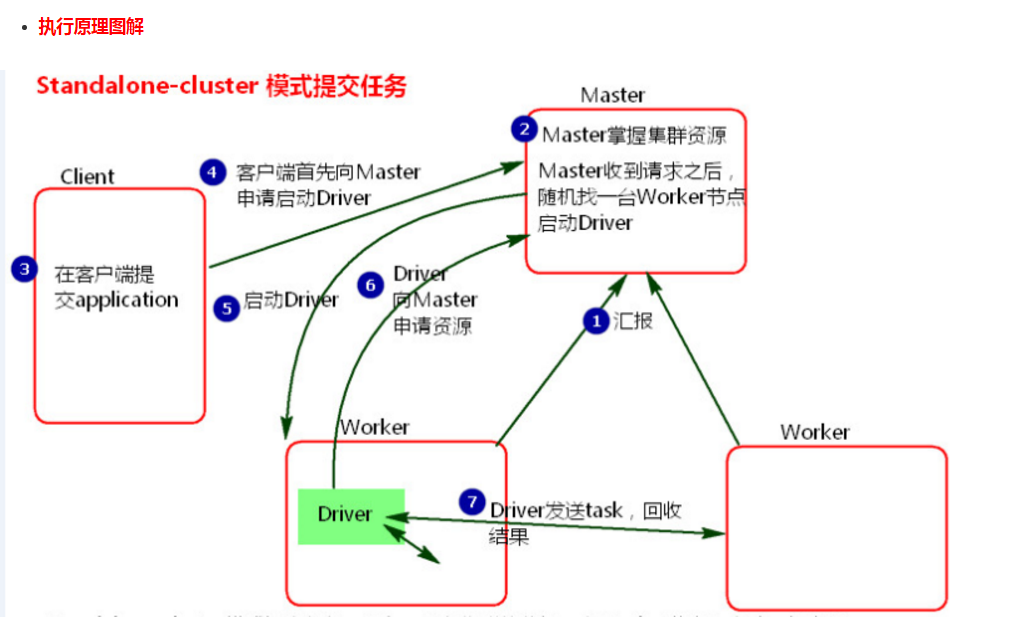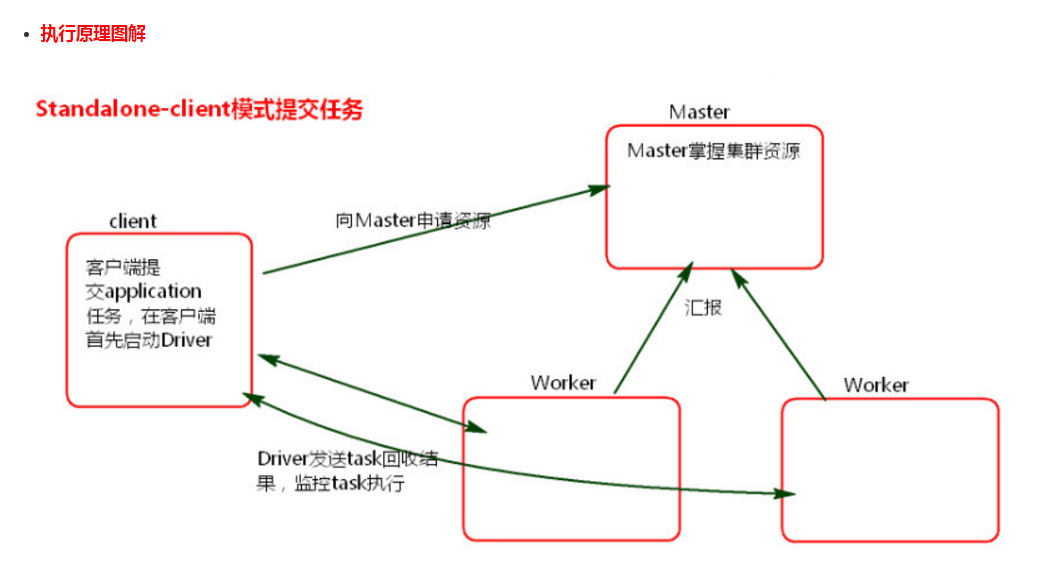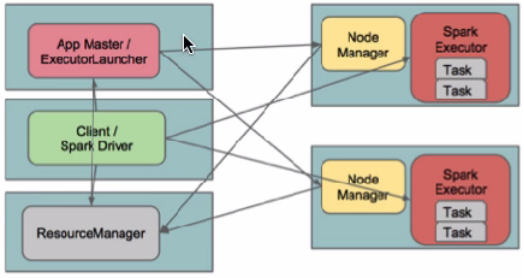Spark Standalone和yarn区别
Spark Standalone模式提交任务
Cluster模式:
./spark-submit \
--master spark://node01:7077 \
--deploy-mode cluster
--class org.apache.spark.examples.SparkPi \
--driver-memory 1g \
--executor-memory 1g \
--executor-cores 2 \
../lib/spark-examples-1.6.0-hadoop2.6.0.jar 100- 执行流程
1、cluster模式提交应用程序后,会向Master请求启动Driver.(而不是启动application)
2、Master接受请求,随机在集群一台节点启动Driver进程。
3、Driver启动后为当前的应用程序申请资源。Master返回资源,并在对应的worker节点上发送消息启动Worker中的executor进程。
4、Driver端发送task到worker节点上执行。
5、worker将执行情况和执行结果返回给Driver端。Driver监控task任务,并回收结果。
- 总结
1、当在客户端提交多个application时,Driver会在Woker节点上随机启动,这种模式会将单节点的网卡流量激增问题分散到集群中。在客户端看不到task执行情况和结果。要去webui中看。cluster模式适用于生产环境
2、 Master模式先启动Driver,再启动Application。
Client模式:
./spark-submit \
--master spark://node01:7077 \
--class org.apache.spark.examples.SparkPi \
--driver-memory 1g \
--executor-memory 1g \
--executor-cores 2 \
../lib/spark-examples-1.6.0-hadoop2.6.0.jar 100
---------------------------------------------------------------------
./spark-submit \
--master spark://node01:7077 \
--deploy-mode client \
--class org.apache.spark.examples.SparkPi \
--driver-memory 1g \
--executor-memory 1g \
--executor-cores 2 \
../lib/spark-examples-1.6.0-hadoop2.6.0.jar 100- 执行流程
1、client模式提交任务后,会在客户端启动Driver进程。
2、Driver会向Master申请启动Application启动的资源。
3、资源申请成功,Driver端将task发送到worker端执行。
4、worker将task执行结果返回到Driver端。
-
总结
1、client模式适用于测试调试程序。Driver进程是在客户端启动的,这里的客户端就是指提交应用程序的当前节点。在Driver端可以看到task执行的情况。生产环境下不能使用client模式,是因为:假设要提交100个application到集群运行,Driver每次都会在client端启动,那么就会导致客户端100次网卡流量暴增的问题。(因为要监控task的运行情况,会占用很多端口,如上图的结果图)客户端网卡通信,都被task监控信息占用。
2、Client端作用
1 . Driver负责应用程序资源的申请
2 . 任务的分发。
3 . 结果的回收。
4 . 监控task执行情况。
Spark on yarn模式提交任务
官方文档:http://spark.apache.org/docs/latest/running-on-yarn.html
Spark-Yarn Cluster模式:
./bin/spark-submit --class org.apache.spark.examples.SparkPi \
--master yarn \
--deploy-mode cluster \
--driver-memory 1g \
--executor-memory 1g \
--executor-cores 2 \
--queue default \
lib/spark-examples*.jar \
10
---------------------------------------------------------------------------------------------------------------------------------
./bin/spark-submit --class cn.edu360.spark.day1.WordCount \
--master yarn \
--deploy-mode cluster \
--driver-memory 1g \
--executor-memory 1g \
--executor-cores 2 \
--queue default \
/home/bigdata/hello-spark-1.0.jar \
hdfs://node-1.edu360.cn:9000/wc hdfs://node-1.edu360.cn:9000/out-yarn-1Spark-yarn Cluster集群模式原理
Spark Driver首先作为一个ApplicationMaster在YARN集群中启动,客户端提交给ResourceManager的每一个job都会在集群的NodeManager节点上分配一个唯一的ApplicationMaster,由该ApplicationMaster管理全生命周期的应用。具体过程:
1. 由client向ResourceManager提交请求,并上传jar到HDFS上
这期间包括四个步骤:
a).连接到RM
b).从RM的ASM(ApplicationsManager )中获得metric、queue和resource等信息。
c). upload app jar and spark-assembly jar
d).设置运行环境和container上下文(launch-container.sh等脚本)
2. ResouceManager向NodeManager申请资源,创建Spark ApplicationMaster(每个SparkContext都有一个ApplicationMaster)
3. NodeManager启动ApplicationMaster,并向ResourceManager AsM注册
4. ApplicationMaster从HDFS中找到jar文件,启动SparkContext、DAGscheduler和YARN Cluster Scheduler
5. ResourceManager向ResourceManager AsM注册申请container资源
6. ResourceManager通知NodeManager分配Container,这时可以收到来自ASM关于container的报告。(每个container对应一个executor)
7. Spark ApplicationMaster直接和container(executor)进行交互,完成这个分布式任务。Spark-Yarn Client模式:
./bin/spark-submit --class org.apache.spark.examples.SparkPi \
--master yarn \
--deploy-mode client \
--driver-memory 1g \
--executor-memory 1g \
--executor-cores 2 \
--queue default \
lib/spark-examples*.jar \
10
spark-shell必须使用client模式
./bin/spark-shell --master yarn --deploy-mode client实际案例:在YARN模式,executor-cores和executor-memory的设置对调度计算机的性能作用很重要
$ ./bin/spark-submit \
--class cn.cstor.face.BatchCompare \
--master yarn \
--deploy-mode client \
--executor-memory 30G \
--executor-cores 20 \
--properties-file $BIN_DIR/conf/cstor-spark.properties \
cstor-deep-1.0-SNAPSHOT.jar在client模式下,Driver运行在Client上,通过ApplicationMaster向RM获取资源。本地Driver负责与所有的executor container进行交互,并将最后的结果汇总。结束掉终端,相当于kill掉这个spark应用。一般来说,如果运行的结果仅仅返回到terminal上时需要配置这个。
客户端的Driver将应用提交给Yarn后,Yarn会先后启动ApplicationMaster和executor,另外ApplicationMaster和executor都 是装载在container里运行,container默认的内存是1G,ApplicationMaster分配的内存是driver- memory,executor分配的内存是executor-memory。同时,因为Driver在客户端,所以程序的运行结果可以在客户端显 示,Driver以进程名为SparkSubmit的形式存在。
如果使用spark on yarn 提交任务,一般情况,都使用cluster模式,该模式,Driver运行在集群中,其实就是运行在ApplicattionMaster这个进程成,如果该进程出现问题,yarn会重启ApplicattionMaster(Driver),SparkSubmit的功能就是为了提交任务。
如果使用交换式的命令行,必须用Client模式,该模式,Driver是运行在SparkSubmit进程中,因为收集的结果,必须返回到命令行(即启动命令的那台机器上),该模式,一般测试,或者运行spark-shell、spark-sql这个交互式命令行是使用
注意:如果你配置spark-on-yarn的client模式,其实会报错。 修改所有yarn节点的yarn-site.xml,在该文件中添加如下配置
<property>
<name>yarn.nodemanager.pmem-check-enabled</name>
<value>false</value>
</property>
<property>
<name>yarn.nodemanager.vmem-check-enabled</name>
<value>false</value>
</property>两种模式的区别(yarn):
cluster模式:Driver程序在Yarn中运行,应用的运行结果不能在客户端显示,所以最好运行那些将结果最终保存在外部存储介质(如HDFS,Redis,MySQL)而非stdout输出的应用程序,客户端的终端显示的仅是作为Yarn的job的简单运行状况.
client模式:Driver运行在Client上,应用程序运行结果会在客户端显示,所有适合运行结果又输出的应用程序(Spark-shell)
Spark-Submit 参数详解:
--master MASTER_URL spark://host:port, mesos://host:port, yarn, or local.
--deploy-mode DEPLOY_MODE Whether to launch the driver program locally ("client") or
on one of the worker machines inside the cluster ("cluster")
(Default: client).
--class CLASS_NAME Your application's main class (for Java / Scala apps).
--name NAME A name of your application.
--jars JARS Comma-separated list of local jars to include on the driver
and executor classpaths.
--packages Comma-separated list of maven coordinates of jars to include
on the driver and executor classpaths. Will search the local
maven repo, then maven central and any additional remote
repositories given by --repositories. The format for the
coordinates should be groupId:artifactId:version.
--exclude-packages Comma-separated list of groupId:artifactId, to exclude while
resolving the dependencies provided in --packages to avoid
dependency conflicts.
--repositories Comma-separated list of additional remote repositories to
search for the maven coordinates given with --packages.
--py-files PY_FILES Comma-separated list of .zip, .egg, or .py files to place
on the PYTHONPATH for Python apps.
--files FILES Comma-separated list of files to be placed in the working
directory of each executor.
--conf PROP=VALUE
--properties-file FILE 从文件中载入额外的配置,如果不指定则载入conf/spark-defaults.conf。
--driver-memory MEM Memory for driver (e.g. 1000M, 2G) (Default: 1024M).
--driver-java-options Extra Java options to pass to the driver.
--driver-library-path Extra library path entries to pass to the driver.
--driver-class-path Extra class path entries to pass to the driver. Note that
jars added with --jars are automatically included in the
classpath.
--executor-memory MEM Memory per executor (e.g. 1000M, 2G) (Default: 1G).
--proxy-user NAME User to impersonate when submitting the application.
--help, -h Show this help message and exit
--verbose, -v Print additional debug output
--version, Print the version of current Spark
YARN-only:
Options:
--driver-cores NUM driver使用的核心数,只在cluster模式使用,默认值为1。
--queue QUEUE_NAME 提交到指定的YARN队列,默认队列为"default"。
--num-executors NUM 启动的executor的数量,默认值为2.
--archives ARCHIVES Comma separated list of archives to be extracted into the
working directory of each executor.
--principal PRINCIPAL Principal to be used to login to KDC, while running on
secure HDFS.
--keytab KEYTAB The full path to the file that contains the keytab for the
principal specified above. This keytab will be copied to
the node running the Application Master via the Secure
Distributed Cache, for renewing the login tickets and the
delegation tokens periodically.
注意:如果部署模式是cluster,但是代码中有标准输出的话将看不到,需要把结果写到HDFS中,如果是client模式则可以看到输出。



